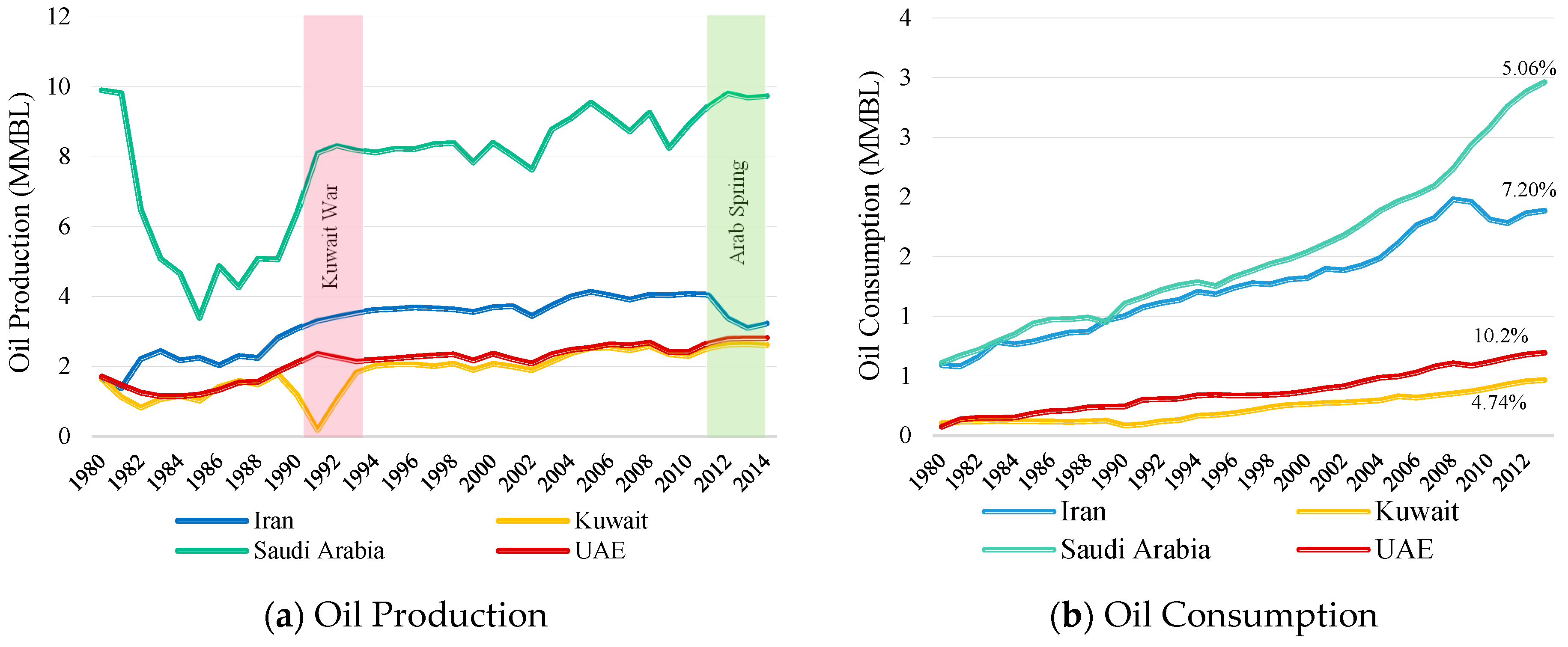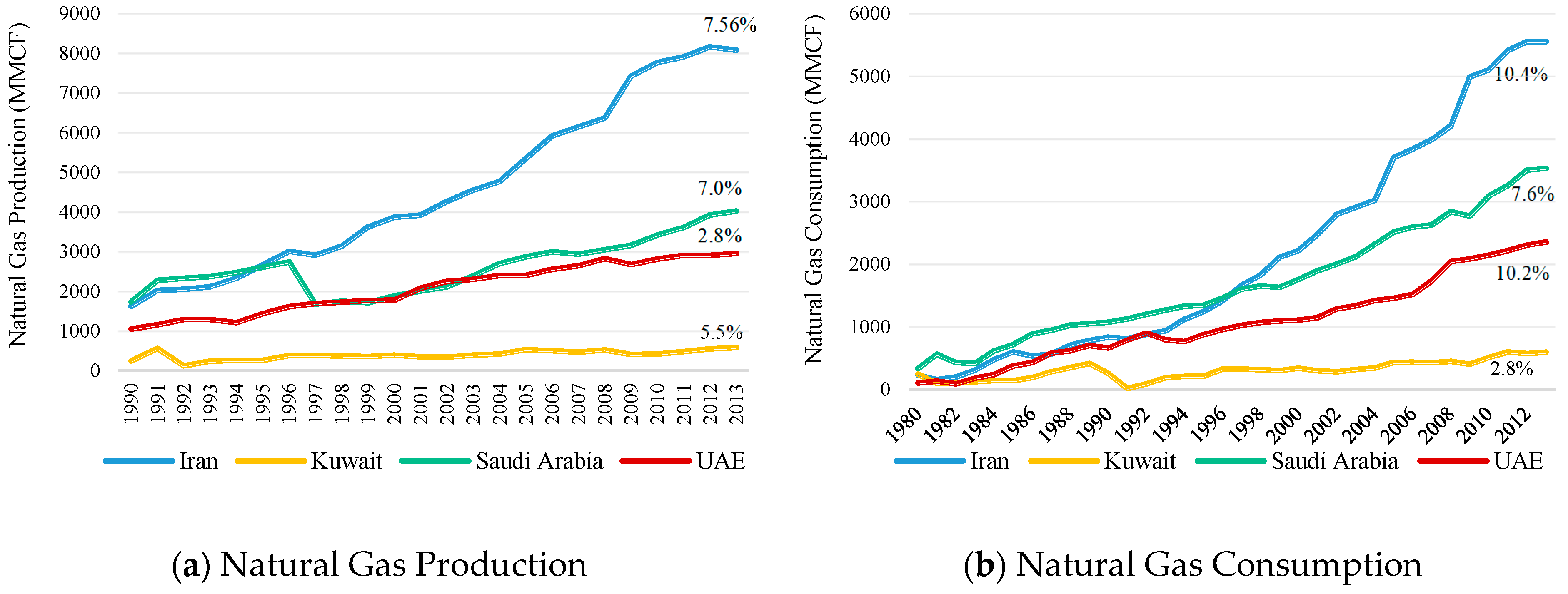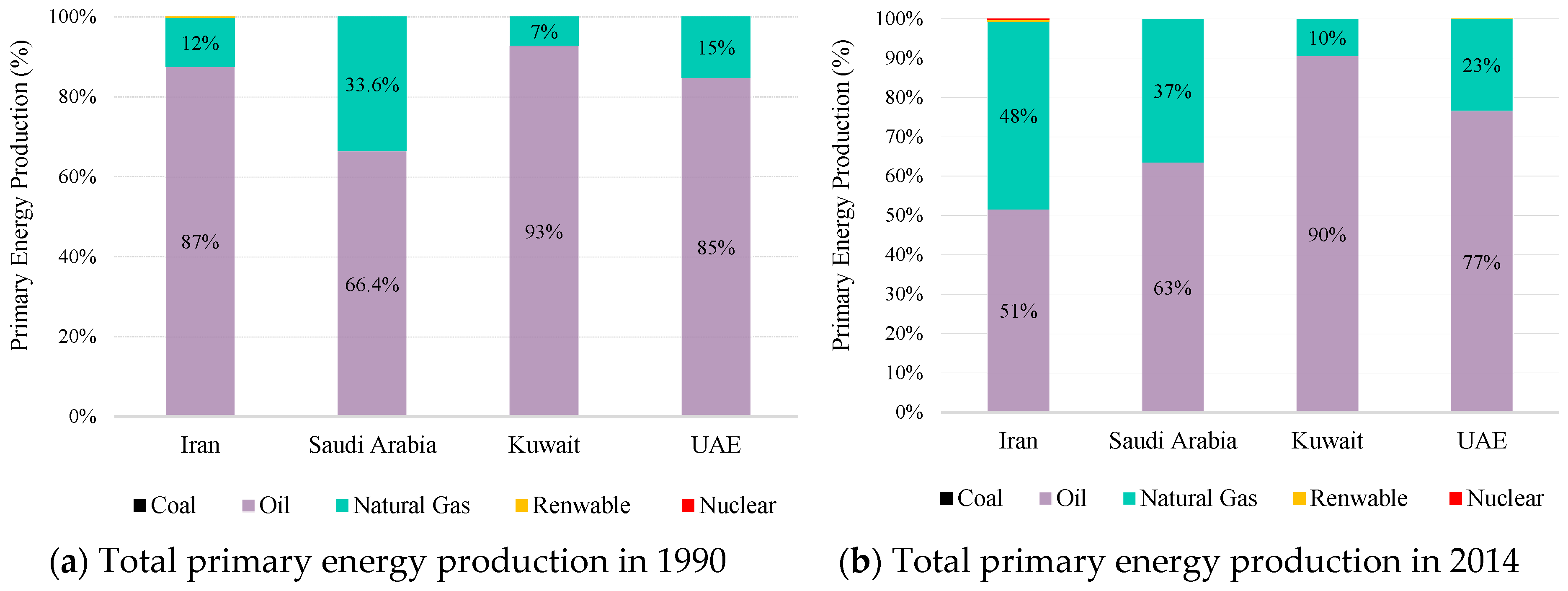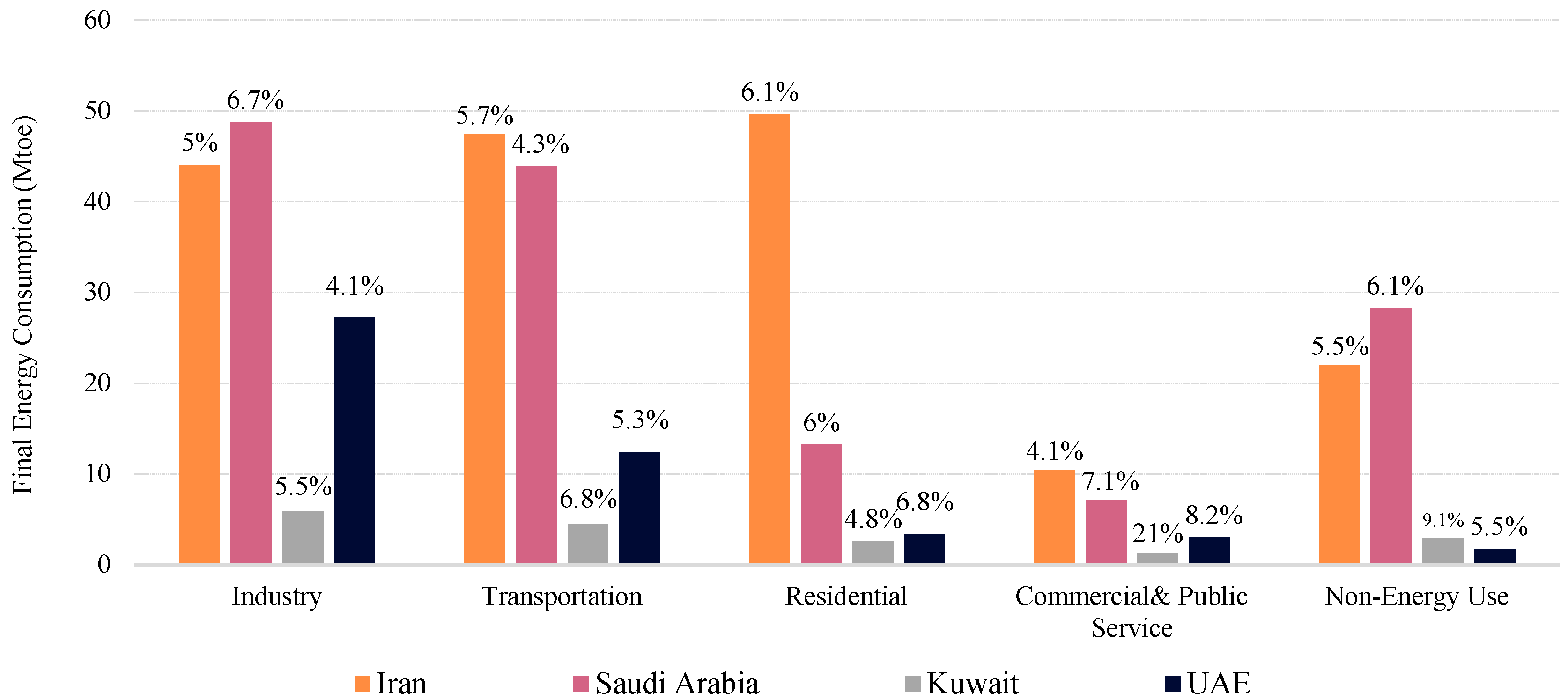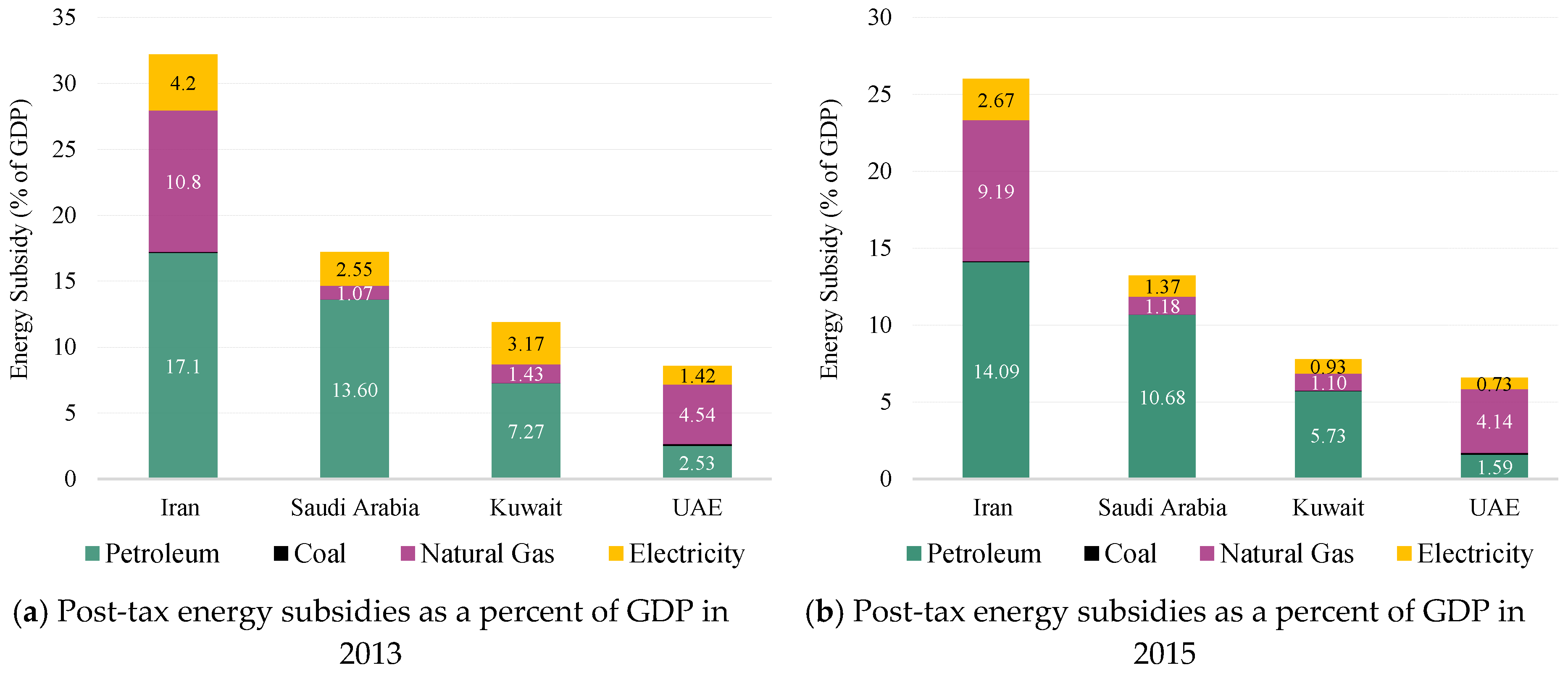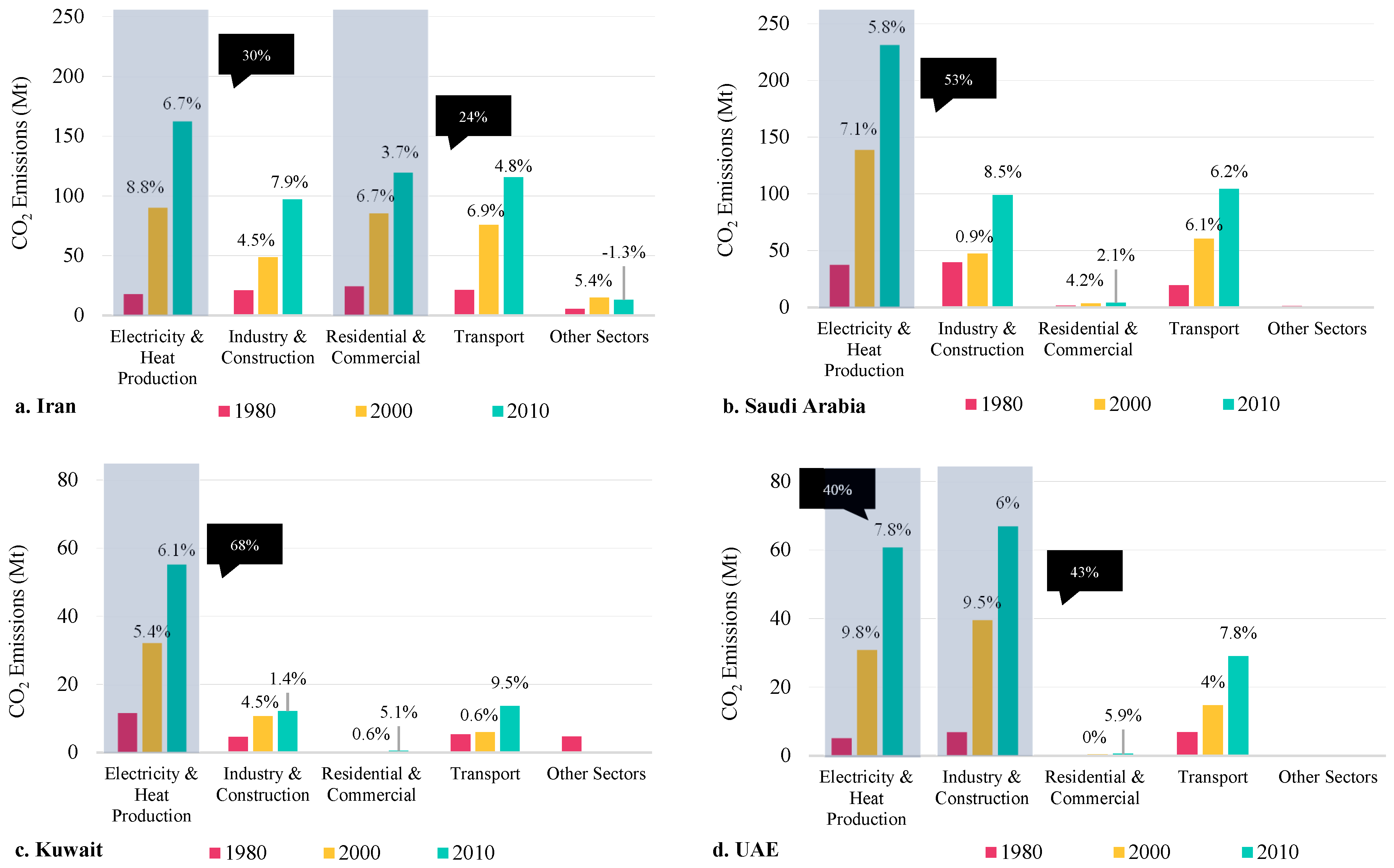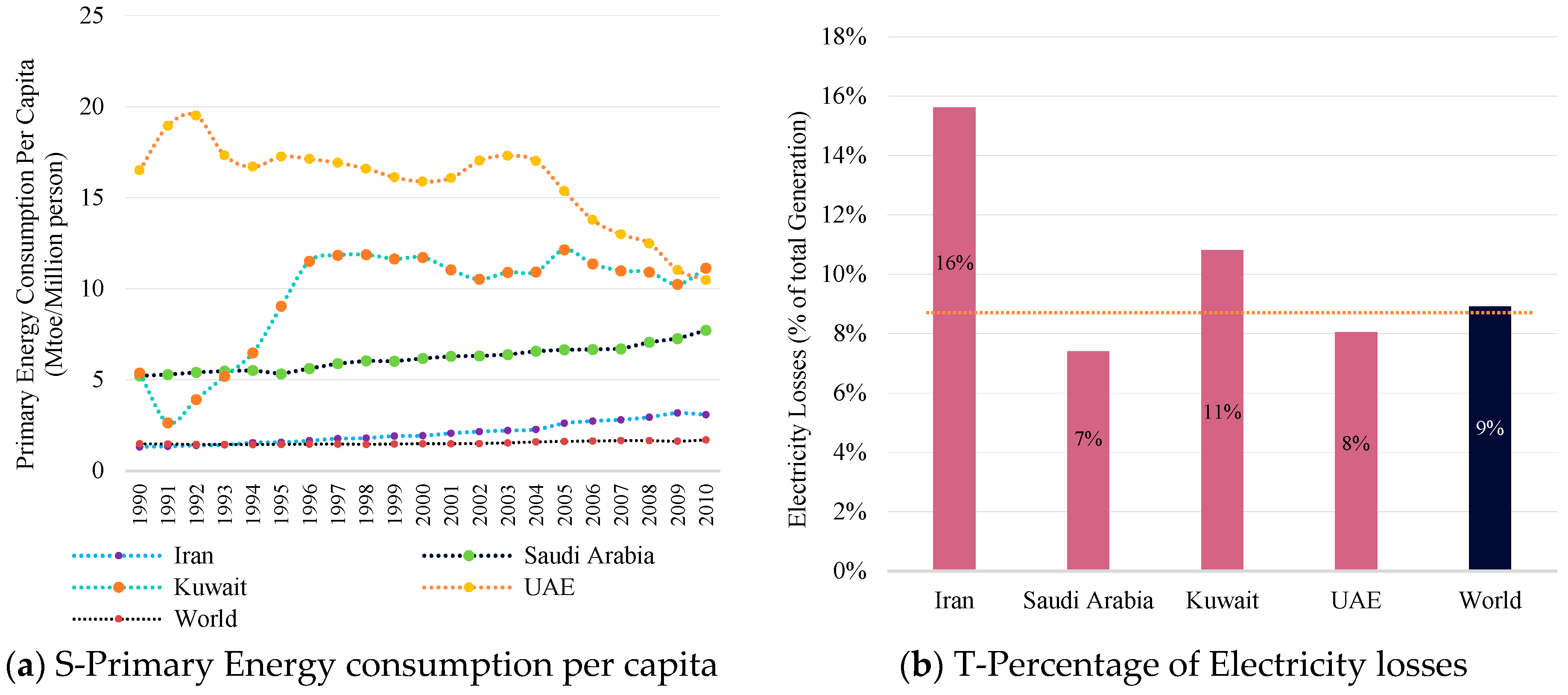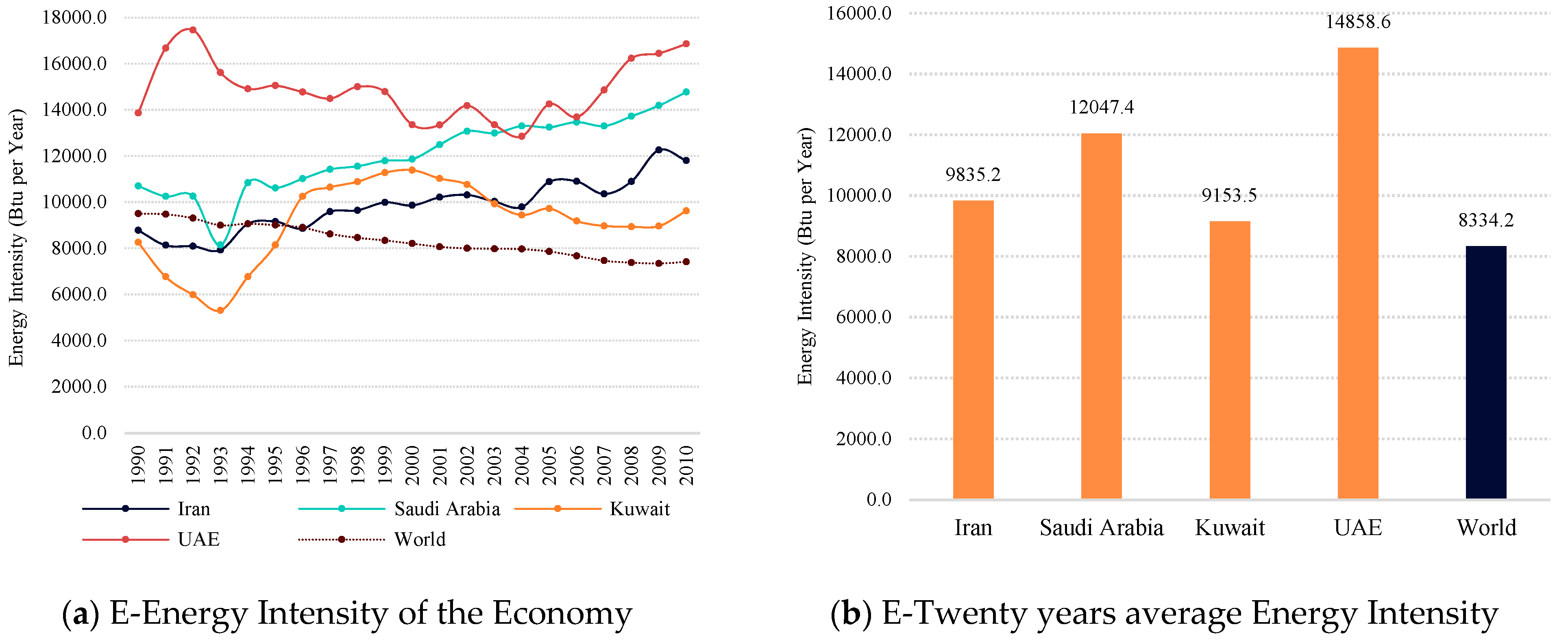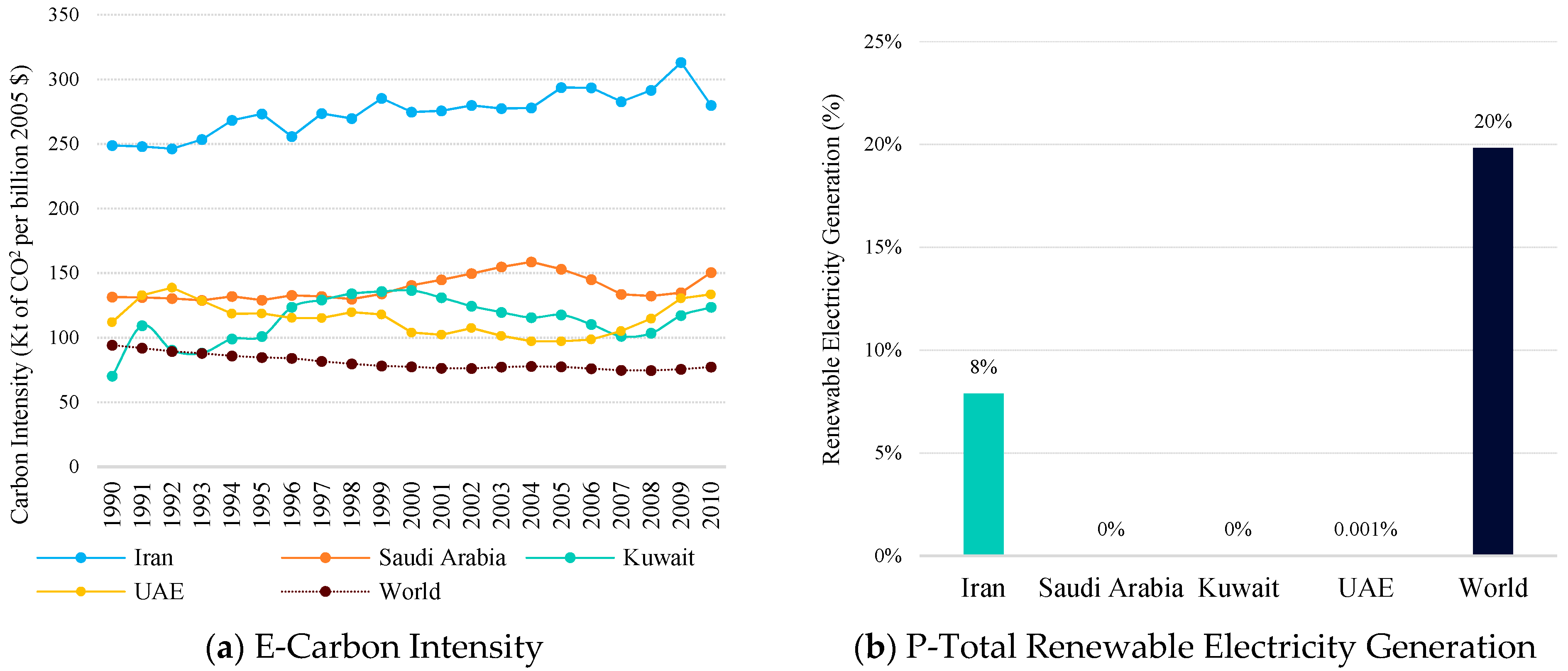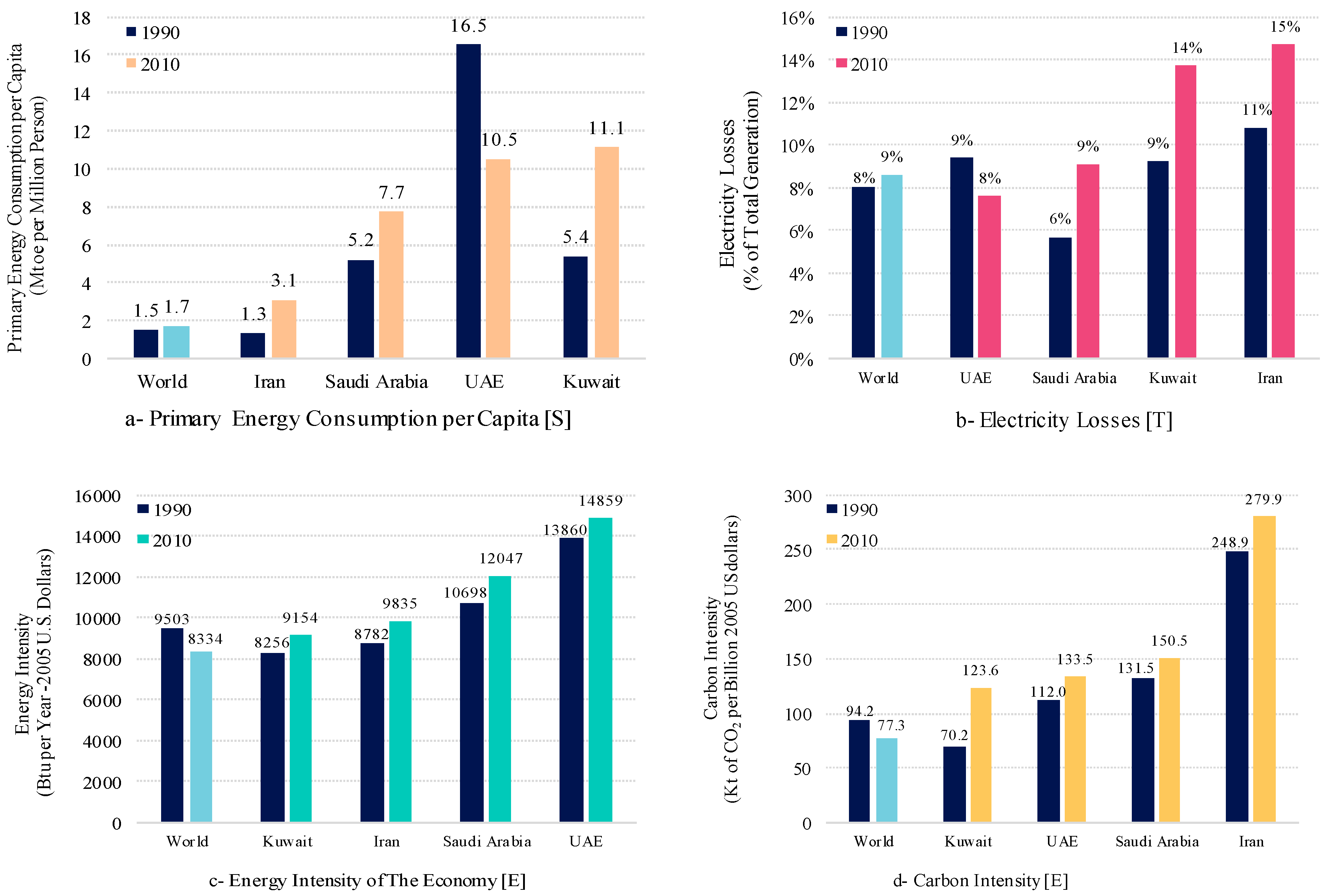1. Introduction
The Middle East is a region that encompasses hydrocarbon-rich economies that are heavily dependent on fossil fuels for its energy supply and domestic consumption. Its role in the global energy market stems from its large fossil fuel reserve that represents over 50% of the world’s proven crude oil, and a third of the global natural gas reserves [
1]. Thus, oil and natural gas resources are considered the main source of income to the majority of countries in the Middle East. The region consists of twelve countries, namely, Bahrain, Iran, Iraq, Jordan, Kuwait, Lebanon, Oman, Qatar, Saudi Arabia, Syria, the UAE, and Yemen. Out of the twelve countries, Saudi Arabia, Iran, Iraq, Kuwait, The UAE, and Qatar are the largest oil exporters in the region.
The rapid growth in Gross Domestic Product (GDP) and population explosion have pushed energy demand increase across the Middle East’s countries. As in 2014, the region’s energy demand represented 5% of the global energy demand with an almost fourfold increase compared to 1970′s levels [
2]. As a result, the share of domestic energy consumption in total production has grown from 4% in 1971 to 24% in 2010 [
3]. Most of the growing demand is mainly coming from four countries, Iran, Kuwait, Saudi Arabia and the United Arab Emirates (UAE), as these four countries alone accounted for nearly 77% of total Middle East energy demand in 2014 [
2]. Although these four countries have large fossil fuel reserves, especially Saudi Arabia and Iran, they are challenged with high energy consumption that has been increasing rapidly over the past thirty years. For instance, Iran and Saudi Arabia have witnessed an increase in total primary energy demand with more than 62.5% in 2014 compared to 1980 levels.
The contribution of the Middle East to global greenhouse gases (GHG) emissions is relatively modest, representing around 7% of global emissions, with electricity and heat production accounting for an average of 38% of the region’s total GHG emissions [
4]. On a regional level, there are a number of countries that significantly account for the largest emission share. In 2010, the Middle East’s GHG emissions reached almost 0.5 GtCO
2eq, where 60% of total emissions were emitted from four countries, Iran, Kuwait, Saudi Arabia and the UAE [
4,
5]. Also, the power generation sector in these four countries alone accounts for nearly 76% of power-related CO
2 emissions.
As presented above, Iran, Saudi Arabia, Kuwait, and the UAE contribute significantly to the Middle East primary energy demand, power generation, and associated CO
2 emissions. Thus, it is important to understand how the development of their energy systems can have implications on the region’s energy future. A number of studies that have examined energy trends in the abovementioned countries individually and in relation to their economic growth. For instance, Alipour [
6] presented a review on fossil and renewable energy resources in Iran and developed a set of scenarios in line with Iran’s 2025 vision. Also, Tofigh and Abedian [
7] presented a review of the energy situation in Iran compared to the world’s energy status by looking at five key energy factors. For Kuwait, Alotaibi [
8] assessed the energy situation in Kuwait by examining historical and current trends and their impacts on future projection with a special focus on the power generation sector. Mezghani and Haddad [
9] examined the relationship between GDP, power consumption and CO
2 emissions in Saudi Arabia and it was found that GDP levels positively affects electricity consumption and CO
2 emissions. Finally, for the UAE, Juaidi et al. [
10] summarized an overview of energy trends in the UAE and GHG emissions and analyzed their impact on renewable energy development.
With many research established to assess energy development in these countries, yet, how trends of energy development across these four countries vary against each other, is still relatively limited. Especially with the significant role that these countries can play in the future sustainable energy development of the Middle East’s region. Thus, the paper addresses the question of how the development of energy systems across the above-mentioned countries changed over the past three decades and what role can they play in the sustainable development of the Middle East’s energy system and emission reduction goals, so the goal of this paper is to examine and compare energy trends and CO2 emissions, in these four countries, denoted as “major emitters “and evaluates the status of their energy systems and how they can affect sustainable energy development in the Middle East.
To achieve this goal, we present an overview of energy trends in four major emitters and energy consumers in the Middle East. Then we expand the work of [
7] to examine and assess energy trends in these countries relative to the global energy status. Such analysis will be relevant to understand the impacts of energy development landscape and related policies in these four countries on the future of energy development in the Middle East. Doing so can be used as a first step to highlight which countries are performing better than others are and the effectiveness of current energy policies. Here we use the same approach presented in [
7] by examining five key energy factors in the four countries of interest compared to the global status over the period of 1990–2010. The structure of the paper is divided into four main sections. The first section presents an overview of fossil energy and available reserves. The second section outlines energy production and consumption trends, energy-related policies, and renewable energy development. In the third section, the status of energy development across the four countries is examined against global energy trends through STEEP analysis. Finally, conclusion and discussion are presented with recommendations on potential energy measures and future research.
2. Background: Fossil Energy
The Middle East has gained its momentous place in the global energy system with the hydrocarbon industry booming during the 1960s. However, the abundance of low-cost energy resources has significantly pushed the growth in energy demand. Oil and natural gas took the lead in supplying the majority of the region’s energy needs, a historical trend since the 1950s that has always been closely tied to the region’s role as a global supplier of both oil and natural gas [
4], as the highest proven oil reserves in the Middle East including oil deposits are located in Saudi Arabia (18% of global reserves) followed by Iran (10.6% of global reserves). This section presents an overview of the total available fossil fuel resources across the four countries and covers two fossil fuel resources: oil and natural gas. Coal will be discussed briefly since the region does not hold large coal reserves and its share in the primary energy mix is relatively modest compared to oil and natural gas. The review presented below covers the period from 1980 to 2014 using data from the International Energy Agency database, World Energy Outlook annual report, International Renewable Energy Agency (IRENA), British Petroleum (BP) Annual Energy Outlook and the World Bank. Also, other national data sources are utilized such as IRAN Renewable Energy Congress and Statistical Center of Iran for data on electricity and energy consumption in Iran.
2.1. Oil
The Middle East holds about 78% of the global proven crude oil reserves that situate the region in an elite position in the global oil market. The large oil reserves are spread out differently across the four countries. The differences between the four countries in their production and available reserves are summarized in
Table 1 below. According to recent reserves estimates, Iran’s total proven oil account for more than 10% of the global oil reserve [
11]. It is also considered the third largest oil reserve holder in the world after Saudi Arabia. However, the expected life span of the country’s total reserves is estimated to be approximately 94 years [
12]. For Kuwait, oil is considered a vital component in its energy supply system. By the end of 2012, Kuwait’s total proven crude oil reserves represented 8% of the global oil reserves [
13]. Yet, most oil fields in Kuwait are over 60 years old that can possibly limit the expansion of production capacity in the future [
13].
With oil reserves around 16% of the world’s total, Saudi Arabia is by far the largest oil producer and exporter in the Middle East and that puts the country on the top of the list compared to the other three as shown in
Table 1. Consequently, it’s economy is largely based on oil, as oil revenues account for around 90% of the total national income and about 50% of its GDP [
9]. On the consumption side, the country is ranked as the world’s sixth largest oil consumer with total energy consumption higher than the global average [
14]. For the UAE, the country is currently ranked as the eighth largest oil reserve in the world, holding about 5.8% of the global oil reserves. While its total population represents only 0.1% of the global population, the country consumes around 0.8% of the world’s total oil consumption [
15].
Across the four countries, oil is a vital component in both energy supply and demand. Saudi Arabia contributes the largest amount of the region’s oil production. Examining oil resources across the four countries, Saudi Arabia tops the list in both reserves, production and related CO2 emissions. Although the UAE has a smaller reserve than Kuwait, its total oil production and consumption are much higher than Kuwait. Moreover, during the past thirty years, oil demand has been growing faster than production across the four countries.
Saudi Arabia and Kuwait’s oil production has been growing with an average annual rate of 1.5%, while Iran and the UAE growth rate reached 2% annually (
Figure 1a). On the other hand, UAE’s oil demand is the fastest, growing at an average annual of 7.20% since 1980 followed by Saudi Arabia as illustrated in
Figure 1. Such rates underline that growing oil requirements will be a challenge to low carbon transition in the next few years.
2.2. Natural Gas
According to the recent estimates of gas reserves in the Middle East, Iran, Saudi Arabia, UAE, and Kuwait are among the largest natural gas reserves, contributing around 63% of the region’s total. Iran tops the list with 19.7% of the world’s available gas reserves, followed by Saudi Arabia with 8.3 trillion m
3, and UAE with 6.1 trillion m
3 as presented in
Table 2 below [
1,
2]
On the consumption side, domestic natural gas consumption in Iran and the UAE has been growing rapidly since 1980 with an average rate of 10.4 % annually (
Figure 2b). For Iran, it is projected that under current consumption rates, Iran’s gas reserves will have an average life span of 166 years [
16]. For Kuwait, its domestic natural gas consumption has always equaled production. However, in the last ten year, Kuwait’s natural gas demand has surpassed domestic consumption due to surging demands from electricity generation especially during the summer months [
2,
17].
On average, CO2 emissions from gas consumption across the four countries reached more than 100 Mt, except in Kuwait that has the lowest consumption levels among the four. Also, historical trends indicate that gas’s growth rates have surpassed oil’s, which imply a faster-growing trend for natural gas demand than for oil. Yet, the capacity of natural gas production to satisfy demand will represent a major challenge in future give under projected energy demand.
Across the four countries, Iran and the UAE are the only two countries depending on coal in their total energy mix. Iran’s total coal reserves are estimated at 1.2 million short tons, yet, it accounted for only 0.21% of its total energy mix in 2008 [
20]. For the UAE, coal supply is mainly coming from imports with a share of 2.5% in the country’s primary energy supply [
5]. From this overview, the four countries have large fossil fuel reserves that have induced the heavy reliance on hydrocarbon resources. Yet, countries like the UAE is planning to adopt clean technology like Carbon Capture and Storage (CCS) to continue using coal in the future. The following section will discuss energy production, consumption, and demand from different economic sectors and trends in energy consumption.
3. Energy Profile
During the past three decades, the Middle East region has experienced a remarkable increase in economic development, population growth, and associated energy demands. Over the period of 1980–2015, the Middle East’s real GDP grew at an average annual rate of 3.5%, while primary energy production and demand grew at an average annual rate of 2% and 5% respectively [
4,
5]. Also, demand for oil and natural gas grew at an annual average rate of 4.2% and 7.8% respectively over the same period [
20,
21]. Under future projections, it is expected that under Business As Usual (BAU), the region’s total primary energy demand will reach 1276.6 Mtoe by 2040 with an average rate of 2.3% annually [
22]. Thus, expanding production capabilities in order to sustain energy exports will be a major challenge for the region’s energy security.
3.1. Energy Production
Energy production mix varies across the four countries in terms of fuel type and its share in total primary energy production. Generally, the contribution of renewable resources is relatively negligible compared to fossil fuels. For Iran, primary energy production mix consists of five main resources: coal, oil, natural gas, hydro and nuclear energy. The country’s energy sector is largely dependent on oil and natural gas to supply domestic energy demands. However, the share of crude oil has decreased during the past two decades as presented in
Figure 3a. On the contrary, the contribution of natural gas has risen from 12% to 48% by 2014 (
Figure 3b). In 2012, Saudi Arabia was acknowledged as the world’s largest producer of petroleum liquids [
23]. Consequently, oil has been supplying more than 50% of Saudi Arabia’s primary energy production since 1980. However, in the past ten years, the contribution of oil in total primary energy production has witnessed a slight decrease from 66% in 1990 to 63% in 2014 (
Figure 3a). Conversely, the share of natural gas has increased to reach 37% in 2014, growing at an annual average of 5.2% annually since 1990 [
24].
Like Saudi Arabia, Kuwait relies exclusively on fossil fuels, primarily oil and natural gas, for its energy supply. Although oil accounted for more than 90% of total Kuwait’s primary energy production, natural gas has been growing at a faster annual rate of 5% compared to oil (3.5%) as shown in
Figure 3 above. For the UAE, the country has two main sources of energy: oil and natural gas, other sources such as coal and solar energy contribute marginally (less than 0.1%) [
24].
3.2. Energy Consumption
Over the past ten years, Iran’s final energy consumption has increased at an annual rate of 5.50% to increase from 74.4 Mtoe in 1990 to 255 Mtoe in 2014 [
6,
7]. Since 2004, Iran’s primary energy consumption has grown by almost 50%. In Saudi Arabia, energy consumption per capita is relatively high compared to the world average [
25]. Over the past two decades, the country’s per capita energy consumption has been rising, reaching four times higher than the world average in 2014 [
22].
Figure 4 below represents total primary energy consumption by sources across the four countries in 1990 and how it changed by 2014.
Based on the energy balance across the four countries, fossil fuels largely dominate both demand and supply energy mix. In addition, the contribution of oil and natural gas varies greatly across the four countries. As some countries rely more on natural gas than oil such as Iran and the UAE, others use more oil than natural gas such as Saudi Arabia and Kuwait.
For energy consumption, residential and industrial sector are generally the largest two consumers across the four countries. In Iran, the residential sector contributes the largest share of 28%, followed by transportation at 26%.
Figure 5 below summarizes and compares energy consumption across different economic sectors in the four countries in 2014. It should be noted that, most of Iran’s natural gas consumed by the household sector that accounts for 39% of total gas consumption and mainly used for heating during the winter months.
3.3. Energy Subsidy
Securing energy to meet demand is a growing concern for countries in the Middle East. According to International Monetary Fund (IMF) estimates in 2011, pre-tax energy subsidies (pre-tax energy subsidies refer to any government action that lowers the price paid by energy consumers. Usually it is measured as the difference between the value of consumption at world and domestic prices [
8]) in the Middle East accounted for about 48% of the global energy subsidies and 8.6% of the region’s GDP costing almost 237 billion dollars compared to a global total of US
$481 billion [
26]. Fossil-fuel subsidies are frequently justified on the basis that they provide support and protection to the poor, through lowering direct and indirect fuel costs. Generally, energy subsidies are useful for low-income groups, for uses such as household daily activities and personal commuting. However, it is highly inequitable when they are provided with the same rates to upper-income groups. In this section, we are focusing on review energy subsidy policy across the four countries. This is mainly due to its significant role in driving energy consumption.
By the early 2000s, Iran was considered among the world’s highest energy intensity, which was strongly tied to the high-energy subsidies system [
26]. Under such low energy prices, Iran’s oil exports were largely affected. By mid-2000s, the country’s oil exports were declining rapidly and imports were mounting to meet domestic demand [
27]. Consequently, in 2010, Iran was the first oil-exporting country to increase significantly its energy prices by almost 20 times and to reform its subsidies framework. The reform was preceded by a communication campaign to educate the population on the growing costs of low energy prices.
Table 3 summarizes Iran’s energy subsidy reform before and after 2010 and implications on energy savings.
Although Iran was the first country among the four to initiate subsidies reform, Saudi Arabia has recently adopted a new reform framework for its domestic energy prices [
34]. According to the IMF estimates, energy subsidies in Saudi Arabia have cost about 107 billion dollars in 2015, which represent almost 13.3% of its GDP same year as shown in
Figure 6b below [
35]. In 2015, the cost of a gallon of high-grade gasoline in Saudi Arabia was
$0.90, while in 2014 it cost
$0.60 [
36]. The Saudi government announced a plan for fuel prices reform in 2016, where it will include higher prices for individuals, industry and government sectors based on consumption rates. The system will allow the household to benefit from lower rates with a consumption limit of 4000 KWh [
34].
Kuwait is the most challenging among the four countries, where energy prices are below international benchmarks and the Middle East’s average [
37]. By the end of 2015, diesel and gasoline prices were 20% below the Gulf Countries’ average prices and 66% below the U.S. In addition, electricity tariffs are considered the lowest in Kuwait at 0.01 USD/KW whereas production costs around 0.14 USD/KW [
37]. Recently, the Kuwaiti government has announced a new reform policy for energy subsidy that will include an increase between 40% to 80% from current fuel prices [
38]. Under this new reform policy, the price of low-octane petrol will rise by 41% to
$0.28/liter, while high-grade petrol will increase by 61% to cost
$0.35 per liter [
38].
For the UAE, the government is taking strong leaps towards cutting fuel subsidies [
26]. In 2015, the country announced a plan to cut transport fuels to be the first country in the Middle East to fully remove fuel subsidies from the transportation sector [
39]. According to the Ministry of Energy in the UAE, the new reform plan will be set on a monthly basis to correspond to global market prices [
40]. Although the UAE is pushing efforts to reform its prices framework, oil prices and electricity tariffs are still below international market levels [
41]. From this overview, it can be concluded that energy subsidies have largely affected energy consumption across the four countries. This is observed from Iran’s case where cutting energy subsidies has significantly influenced the growth of energy consumption [
42].
3.4. Renewable Energy Deployment
The expected gradual depletion of fossil fuel reserves along with an increase in energy prices is driving global energy supply towards more renewable resources over the next decade. Under these circumstances, untapped renewable resources represent a huge potential for fueling a large portion of growing energy demands. The Middle East is no exception, especially the region has a significant potential for renewable energy development given its geographic and environmental characteristics, particularly for solar and wind energy [
43]. Although the region holds the largest potentials for renewable energy, not least solar energy, renewable energy still underdeveloped, contributing only about 5 % of the total Middle East primary energy supply mix [
5]. For the four countries examined in this paper, the share of renewable energy in the total primary energy mix is relatively modest in Iran, the UAE, and nearly less than 1% in Kuwait and Saudi Arabia. Yet, the four countries have committed to increase the share of renewable deployment as part of their national commitment after the Paris climate agreement in 2015. A brief overview of the potentials of renewable energy deployment and renewable energy targets in the four countries is presented below.
Iran is among the countries who have a technical potential to set up 40,000 MW of renewable power plants, out of which 15,000 MW were proved to be economically viable [
44]. After the sanctions removal, Iran’s power capacity is expected to increase significantly, which infers possibly larger renewable output [
45]. During the Paris Climate Agreement in 2015, Iran has officially committed to a 4% cut in its total GHG emissions by 2030. The climate plan was linked to a renewable energy target of 5 GW by 2020 and an additional 7.5 GW in 2030 [
46]; however, the country has the ability for an even larger deployment. According to the study of Iran-German cooperation [
47], Iran has a potential of increasing renewable penetration from 3% to over 38% by 2030 and over 100 GW of renewable capacity [
48].
Saudi Arabia’s electricity consumption is nearly 256 TWh/y, the highest consumption of all Gulf Cooperation Council (GCC) countries [
24]. In addition, peak power demand is expected to grow from 55 GW to 121 GW by 2032, with a gap of 61 GW between output and demand volume [
49]. Yet, studies have shown that the country has huge potential for renewable resources, especially solar, that can be exploited to cover this gap [
50]. Initially, Saudi Arabia has set a target 54 GW of renewables by 2032 [
51]. The target was projected to support the country’s plan to increase generation capacity to 120 GW. However, recently the plan has been relaunched under 10% of renewable generation and more focus on natural gas usage. The new target includes a target capacity of 9500 MW of renewable by 2023 [
52,
53].
Kuwait’s power system is extensively based on hydrocarbon resources as previously discussed. In addition, an expected increase in power demand to reach 30 GW by 2030 will significantly challenge the power supply in the future [
54]. Consequently, the country adopted a diversification plan with a goal to increase the share of renewable generation to 15% by 2030, focusing mainly on solar and wind technologies [
15].
Table 4 presents a breakdown for the expected capacity of different RETs in Shagaya Park.
In the UAE, electricity consumption has increased exponentially in the last three decades [
55]. With large reliance on hydrocarbon resources for energy supply, the country has set three targets; 27% of Renewable Energy Technologies (RETs) by 2020, 30% by 2030 and recently 50% from renewables by 2050 [
56]. A study conducted by Masdar Institute to examine the viability of different RETs in the UAE reported potential of 28 GW (40% of total capacity) from renewables can be achieved by 2030 compared to BAU scenario [
55]. Results from the study indicated that under this level of deployment a reduction of 8.5% in oil consumption and 15.6% in natural gas can be attained by 2030 [
57].
Table 4 presents a breakdown for the expected capacity of different RETs across the four countries and planned renewable energy targets by 2020 and 2030.
From the above overview, it can be noted that the four countries are taking serious steps to reduce their reliance on fossil fuels and there is a growing trend towards renewable energy especially solar and wind. However, interest in renewable energy has been subject to the volatility in oil prices that will largely influence renewable penetration in the future.
4. CO2 Emissions
Iran is considered among the top ten CO
2 emitters in the world [
36]. Between 1970 and 2010, Iran’s CO
2 emission grew at an average annual rate of 6.69% [
22]. On the other hand, between 1995 and 2015, Saudi Arabia’s CO
2 emissions increased by an average of 5.2% annually [
23]. In addition, Saudi’s share of global CO
2 emissions has risen from 0.7% in 1990 to reach 1.4% in 2015. The largest increase happened between 2008 and 2010, where emission grew by an average annual of 7.5%. About 70% of Saudi Arabia’s fossil fuel-related CO
2 emissions are coming from the combustion of oil products and the remaining 30% are from natural gas [
58].
CO
2 emissions in Kuwait are among the highest in the world as well [
4]. Since 1970, emissions grew by an average of 5.3% per year [
22]. In addition, CO
2 emissions per capita grew at a rate of 1.13% annually to reach 39 metric tons in 2010, compared to a world average of 4.54 tons and the U.S. of 18 tons [
8]. The UAE is ranked among the world’s largest per capita emissions from fossil fuel combustion [
36]. Since 1980, emissions per capita grew at an average annual of 1.3% to reach 44 tons in 2010. Yet, the country’s absolute emissions correspond to 0.7% of worldwide CO
2 emissions [
36]. Most of the country’s CO
2 emissions come from electricity generation and petrochemical industrial sector.
Figure 7 below summarizes CO
2 emissions from different economic sectors for the four countries.
5. Methods: STEEP Analysis
In this section, the STEEP analysis is applied to understand past and current trends of energy based on determined factors drawing from the work of [
7]. This will help to gain insights for key factors that may have an influence on the development of energy systems in the future. STEEP stands for five main categories: Social, Technological, Economical, Environmental and Political [
7] (STEEP Social includes factors like population, consumption behavior, income level and lifestyles), Technological (new technology that would influence the development of energy systems, consumption and efficiency), Economical (economic factors like income level, international trade and taxes), Environmental (includes factors from natural systems such as: wind, water and food ) and Political (political changes or development that would have an impact on environmental and energy policies, trades, carbon taxes and energy supply [
9]). This analysis is commonly used to understand the impacts of development by gaining insights from past trends [
7,
59]. In the field of energy development, STEEP has been used to identify what are the suitable mechanisms needed for sustainable energy development [
7]. Here, the STEEP structure is used to examine energy performance by analyzing a key factor in each group. The selection criteria for these indicators is based on changes that are most likely to affect the energy status significantly. Five key factors are selected in this analysis: from social (Total Primary Energy Consumption per Capita). We choose primary energy consumption per capita in order to capture the effect of per capita income level on energy consumption, as affluence is directly linked to energy use. Technological (Percentage of Electricity Distribution Losses), this is useful to underline the status of technology development through examining the efficiency of electricity distribution. Economical (Energy Intensity), this reflects the energy intensity of the economy, by means how much energy is required for economic growth. Environmental (Carbon Dioxide Emissions), this is used to examine how the country is progressing towards planned climate goals and associated environmental impacts from energy consumption. Political (Total Renewable Electricity Net Generation), this can be used as a way to indicate the commitment of policymakers commitment to achieve climate goals and push renewable deployment [
7]. The analysis will compare these indicators to the global average using available energy data over the period 1990 to 2010. Data used are from International Energy Agency’s energy statistics, IEA’s Annual Energy Outlook and British Petroleum’s Energy outlook covering the five main STEEP factors.
As presented in
Table 5 below, the four countries are lagging behind the world average across the five indicators. The twenty years average in the five categories indicates that there is a gap in suitable energy strategies to push the sustainable development of their energy system. However, in some cases, some countries are performing better than others. For Instance, Iran is the closest to the world average under the indicator of renewable electricity generation. Although the share of renewables is lower than the global average, the average growth rate of renewable electricity in Iran (3.38%) during the past ten years was significantly higher than the global average (0.84%). On the other hand, under the indicator of electricity losses, the UAE is performing better than the other three countries and stands below the global average.
6. Results
For the first indicator, Iran is the only country close to the world average and the UAE is the highest. This is linked to the vast economic growth and the large expansion in non-hydrocarbon economic sectors in the UAE mostly manufacturing especially during the past ten years, putting the country as the second largest economy in the Middle East [
62]. The twenty-year average of energy intensity in the UAE is nearly ten times higher than the global one as shown in
Table 5 above. However, on the scale of annual growth rates, the UAE energy intensity has been decreasing (average annual rate of 2.3%), compared to an increase in world’s average of 0.7% annually (
Figure 8a). This underlines the impact of the recent energy efficiency strategies planned by the government. Iran and Kuwait have the highest average growth rates, 4.56%, and 3.9% respectively, that is almost five times higher than the global average annual growth rate (0.71%) as shown in
Figure 8a.
In the second indicator, electricity losses are highest in Iran (electricity losses include transmission losses between generation point to distribution point and distribution to consumers). Since 1990 to 2006, electricity losses have increased by 4.5% annually. However, by 2007, losses rates have decreased by an average annual of 14%. By the end of 2009, losses in Iran reached around 27.17 TWH at a cost of 2.19 Billion Dollars [
63]. With the high cost of electricity losses, the country has set a plan to reduce transmission losses from 16% in 2010 to 7% by 2025. Kuwait is the second largest with average electricity losses of 1.2 times higher than the world average (
Figure 8b). Saudi Arabia and the UAE are both below the world average, yet Saudi Arabia’s average annual growth is 7 times higher than the world average (growing at an average of 2.6% compared to world’s average of 0.36%). On the contrary, the UAE’s average annual rate indicates noticeable improvement in electric power distribution. Since 2008, total electricity losses decreased by an average annual of 5%.
Regarding the third indicator, the UAE has the lowest performance among the four (
Figure 9a). The twenty- year average energy intensity is 1.5 times higher than the global average as presented above in
Table 5. In addition, Iran and the UAE had almost the same average growth rate over the past twenty years while Kuwait is the closest to the world average (
Figure 9b). The large difference between the four countries and the global average is directly linked to varying dependence on fossil fuel for supplying energy demand. For instance, Iran has a heavy reliance on energy-intensive industries for domestic economic production and export. It is also largely reliant on oil products to meet domestic demand as well as requirements from energy-intensive petrochemical and metal industries. Conversely, UAE is more reliant on natural gas but uses nearly 481 tons of oil equivalent to produce only 1 million US. dollars of GDP, which is four times higher than the United States [
4]. In addition, climatic conditions, high levels of desalination needs and poor energy efficiency have driven the high levels of energy intensity in the four countries. Finally, fuel subsidies have affected demand increase from energy-intensive products such as automobiles and air-conditioners.
The environmental indicator examined through carbon emission intensity is strongly linked to both energy intensity and primary energy consumption. By examining the four countries relative to the world average, growing energy consumption has induced the growth of carbon dioxide emissions. Iran and Kuwait have the lowest levels among the four. Between 1990 and 2010, Iran’s carbon emissions from energy consumption have increased 0.6% annually, reaching 280 KtCO
2 per billion, that is almost 3.5 times higher than the world average (
Figure 10a). With regard to the average growth rate, Kuwait is the fastest, growing at an average of 3% annually, followed by the UAE (0.93%) and Saudi Arabia (0.72%). The high levels of carbon emissions correlate with major changes required in both energy production and consumption to meet the world’s average.
Across the four countries, Iran is the only country with a large share of renewables in its total electricity mix. Recently, the UAE has realized the importance of renewable utilization to promote and mandate energy efficiency to become at the forefront of renewable deployment in the Middle East. Kuwait and Saudi Arabia are lagging behind in terms of renewable generation (
Figure 10b), however, as previously discussed, both countries have set ambitious targets to increase renewable electricity generation and reduce dependence on fossil fuels.
7. Discussion
From the analysis, it can be seen that high-energy intensity is a huge challenge facing the four countries examined in this paper. Large dependence on fossil fuel and carbon-intensive economies will threaten the success of future environmental and energy policies. Some countries have witnessed a decreasing trend in some indicators, however, their situation is still higher than the world average. For example, the UAE showed a decreasing trend in primary energy consumption per capita and the percentage of electricity losses, yet the values of these two indicators are still higher than the world’s average.
Figure 11 below compares between the beginning and end of the analysis period for the four countries. Countries are ordered based on their proximity to the world’s average in 2010. Renewable electricity generation is not included as the relative changes from 1990 are very modest compared to other indicators.
Although the UAE values were much higher than world’s average across some indicators as discussed above, the country’s both energy consumption per capita and electricity losses has decreased significantly over the analysis period as shown in
Figure 11 below. The UAE has already started to take serious steps towards integrating nation-wide energy efficiency strategies that are reflected in the decrease in energy consumption per capita since 1990. On the other hand, the four factors illustrated below have been increasing rapidly in Iran, Saudi Arabia, and Kuwait. In the social indicator, Kuwait had the largest increase with about 105% from 1990. This underlines required efficiency plans that encourage less energy-intensive activities to attain sustainable development on the near and long term, this in parallel to structural changes in both energy and industry sectors. From this trends analysis, it can be noted that the development of the energy sector and sustainability policies were largely ineffective during the past twenty years [
64]. This implies the necessity for suitable policies to support energy diversification and energy demand management. Such policies are central for energy development in the four countries and for the region. Findings from the STEEP analysis showed that inefficient energy production, consumption have played a role in the deterioration of the energy landscape of the four countries compared to the global energy system. In addition, the large fossil fuel reserves in these countries like other Middle East’s countries have caused harm than good. Reliance on fossil fuel encouraged low-cost fuel prices and induced the increase in CO
2 emissions trends that is one of the most perilous threats to sustainable growth [
65].
Inefficient energy production and consumption have also played a role in the deterioration of energy systems across the four countries. Thus, developing new energy technologies parallel to diversifying energy sources will assist in harnessing future climate targets and will drive the sustainable development of the energy sector. Trends of energy intensity across the four countries highlight the urgency of decoupling energy consumption and economic development, which could potentially have a huge impact on revenues from fossil fuel exports. Such impacts could be addressed through regional cooperation among the Middle East’s countries that place emphasis on energy demand management and sustainable economic growth [
66,
67]. High trends of energy consumption across of the four countries underline the gap in effective energy strategies to mandate consumption. To address this problem a number of strategies can be introduced to increase energy efficiency that includes a wide range of financial instruments to support impactful action plans across all economic sectors with special emphasis on transportation, heavy industries, power generation, and water desalination. Also, the ramification of energy subsidies across the four countries has played a significant role in driving energy consumption as it was highlighted in trends of energy consumption per capita across the four countries [
67]. Even though the four countries are taking major steps in subsidy reforms, energy prices remain relatively low. Adequate gradual prices adjustments that are accompanied by consensus building and community engagement will have a strong implication in reducing energy demand [
67].
Another dimension to take into account is the distribution of GHG share in relation to climate change equity. Countries like the U.S and China can still achieve economic growth with fossil fuel dependence and minimum consequence from climate change while developing countries that are still economically expanding will have larger impacts from climate change [
68]. Especially, fossil fuels exporting countries that are economically based on fossil-based industries with a rapidly growing demand. Thus, countries addressed in this paper among other large fossil producers represent a huge potential for low-carbon economic strategies. However, there is a gap in providing suitable policies that would facilitate the transition to low-carbon and renewable resources [
68]. Although the Paris Climate Agreement represented a major milestone in addressing GHG emission reduction. Yet, we see countries like Saudi Arabia has backtracked its emission target and chose to invest in natural gas. Therefore, there is an urgency for liability policies that take into account the distribution of resources alongside to contribute to GHG emissions and will provide a strong incentive for RETs deployment [
69]. In addition, such policies will mobilize regional mechanisms for resources distribution and emission responsibilities and would assist in addressing climate change and low-carbon economic growth in a more meaningful manner.
The analysis in the review section showed that across the four countries, renewable energy targets are part of the future energy agenda. Yet, emission trends showed that there is a gap in suitable energy policy that is strongly linked to climate goals. Additionally, the interrelation between energy demand management and deployment of renewable energy technology will have strong impacts on CO
2 emissions reduction in the future. Such trends reveal that developing energy transition policies that are tailored around carbon emissions reduction is central for achieving climate targets across the four countries. Finally, a consistent policy is imperative to layout the foundation for suitable energy development strategy and make planned renewable targets reality [
8,
67]. The UAE provides a good example with the ongoing efforts to push the competitiveness in renewable energy deployment across the Middle East. Yet the regulatory framework is still important to provide effective mechanisms and to maintain the leadership of these countries in the global energy market.
8. Conclusions
The paper aimed at examining energy trends and CO2 emissions in four major emitters in the Middle East to better understand the status of their energy systems and how they can affect sustainable energy development in the region. Challenges in the four countries examined in the paper are biggest due to their large fossil fuel reserves that induced intensive fossil fuels consumption. Thus, it was important to examine their energy status and pinpoint challenges to be addressed to pave the way for sustainable economic growth and energy development. From the review, it can be noted that fossil fuels supply more than 95% on average across the four countries. Such reliance on fossil fuels will stand as one of the critical challenges on the near-long term. It is also worth recalling that, energy consumption and electricity demand have been rising rapidly in the past ten years. Knowing that the power generation sector is based either on natural gas or on a mix of oil and natural gas, the adoption of renewable resources is rather essential. It was also discussed that more than 50% of total energy and electricity are consumed in industry, transportation and building sector underlining the important role of these sectors in reducing energy intensity and related emissions.
The energy profiles underline that fossil fuels play the main role in the region’s energy development. As it has been presented in the ways of how energy supplied in these countries that are considered one of the growing concerns that these countries will face in the near future. Historical energy trends showed that the rapid growth in energy consumption in the four countries will be highly expected in the next few years. In addition, growth will be underpinned by subsidized fuel prices, which will hinder the transition to clean energy sources. In addition, rapidly increasing domestic energy requirements can potentially immensely limit their capacity to export to the global market in the future. All these factors can lead to an increase in the region’s total share in global CO2 emissions. Tackling these issues will require a significant contribution from governments, stakeholders, societies’ behavior and policymakers.
By examining the structure of energy subsidy in the four countries, it was indicated that it has largely pushed the significant increase in energy consumption. Finally, a comparative assessment is presented to evaluate energy trends in the four countries relative to global status. The analysis presented in this paper showed that the four countries are major energy influencers in the Middle East. Geographical proximity, especially between Saudi Arabia, Kuwait and the UAE, comes with great advantage for a potential partnership in renewable deployment and sustainable development for energy systems in the Middle East. In addition, the similarity in climatic conditions and the structure of their regulatory frameworks can allow these countries to work together to advance renewable energy development and push the implementation of effective energy policies. Such collaboration is strongly tied to ongoing political unrest when energy is concerned, yet such political obstacles could be possibly eased and have more prospects for progress if the scientific basis of these countries’ role is clear, and identified. Thus, there was great importance of examining these counties together and identify their influence on the historical and current development of energy in the Middle East and highlight possible future implications. The main limitation of this study is examining energy trends without a major emphasis on policies associated with those trends. In addition, the five main STEEP factors addressed in this paper can be extended to include other parameters such as energy management policies, fuel prices and the efficiency of available renewable energy technologies. Future research can examine possible policy cooperation across the four countries and the impact of these policies on energy development and economic diversification for the whole Middle East region.
